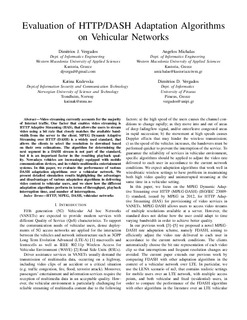| dc.contributor.author | Vergados, Dimitrios | |
| dc.contributor.author | Michalas, Angelos | |
| dc.contributor.author | Kralevska, Katina | |
| dc.contributor.author | Vergados, Dimitrios D. | |
| dc.date.accessioned | 2019-07-09T07:40:08Z | |
| dc.date.available | 2019-07-09T07:40:08Z | |
| dc.date.created | 2019-02-20T18:05:20Z | |
| dc.date.issued | 2019 | |
| dc.identifier.isbn | 978-1-5386-7272-3 | |
| dc.identifier.uri | http://hdl.handle.net/11250/2603826 | |
| dc.description.abstract | Video streaming currently accounts for the majority of Internet traffic. One factor that enables video streaming is HTTP Adaptive Streaming (HAS), that allows the users to stream video using a bit rate that closely matches the available band-width from the server to the client. MPEG Dynamic Adaptive Streaming over HTTP (DASH) is a widely used standard, that allows the clients to select the resolution to download based on their own estimations. The algorithm for determining the next segment in a DASH stream is not part of the standard, but it is an important factor in the resulting playback quality. Nowadays vehicles are increasingly equipped with mobile communication devices, and in-vehicle multimedia entertainment systems. In this paper, we evaluate the performance of various DASH adaptation algorithms over a vehicular network. We present detailed simulation results highlighting the advantages and disadvantages of various adaptation algorithms in delivering video content to vehicular users, and we show how the different adaptation algorithms perform in terms of throughput, playback interruption time, and number of interruptions. | nb_NO |
| dc.language.iso | eng | nb_NO |
| dc.publisher | Institute of Electrical and Electronics Engineers (IEEE) | nb_NO |
| dc.relation.ispartof | 2018 Global Information Infrastructure and Networking Symposium (GIIS) | |
| dc.title | Evaluation of HTTP/DASH Adaptation Algorithms on Vehicular Networks | nb_NO |
| dc.type | Chapter | nb_NO |
| dc.description.version | acceptedVersion | nb_NO |
| dc.identifier.doi | 10.1109/GIIS.2018.8635721 | |
| dc.identifier.cristin | 1679353 | |
| dc.description.localcode | © 2018 IEEE. Personal use of this material is permitted. Permission from IEEE must be obtained for all other uses, in any current or future media, including reprinting/republishing this material for advertising or promotional purposes, creating new collective works, for resale or redistribution to servers or lists, or reuse of any copyrighted component of this work in other works. | nb_NO |
| cristin.unitcode | 194,63,30,0 | |
| cristin.unitname | Institutt for informasjonssikkerhet og kommunikasjonsteknologi | |
| cristin.ispublished | true | |
| cristin.fulltext | original | |
| cristin.qualitycode | 1 | |
